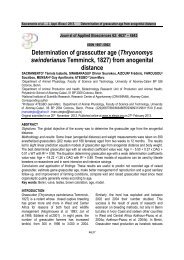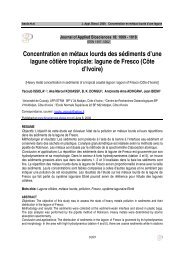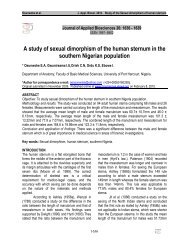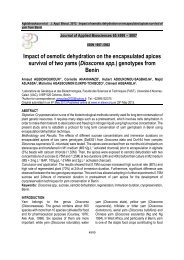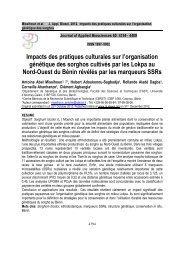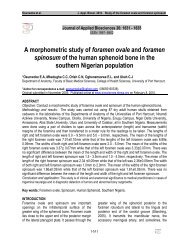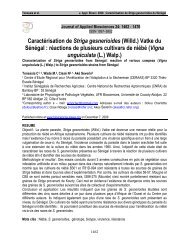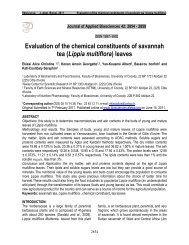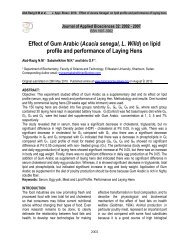Biofuels in Tanzania: Status, Opportunities and Challenges
Biofuels in Tanzania: Status, Opportunities and Challenges
Biofuels in Tanzania: Status, Opportunities and Challenges
You also want an ePaper? Increase the reach of your titles
YUMPU automatically turns print PDFs into web optimized ePapers that Google loves.
Anthony M. Msh<strong>and</strong>ete.J. Appl. Biosci. 2011. <strong>Biofuels</strong> <strong>in</strong> <strong>Tanzania</strong>: <strong>Status</strong>, <strong>Opportunities</strong> <strong>and</strong> challengesii. Blend<strong>in</strong>g Targets Be calculated <strong>in</strong> relation to l<strong>and</strong> requirement <strong>and</strong> variation on productivity potential.Aim at ma<strong>in</strong>stream<strong>in</strong>g biofuels <strong>in</strong> the energy vision of <strong>Tanzania</strong>.Set a target of achiev<strong>in</strong>g certa<strong>in</strong> percentage of blend<strong>in</strong>g <strong>in</strong> conventional fuels with biodiesel orbioethanol, at a specified time frame.iii.L<strong>and</strong> use policy <strong>and</strong>marg<strong>in</strong>al l<strong>and</strong>The policy should consider <strong>and</strong> recognize the existence <strong>and</strong> right of commons by avoid<strong>in</strong>gdangerous assumptions about the extent of “marg<strong>in</strong>al” l<strong>and</strong>s <strong>and</strong> how they are to be def<strong>in</strong>ed.Scientific studies should be carried out to determ<strong>in</strong>e who lives on these “marg<strong>in</strong>al” l<strong>and</strong>s <strong>and</strong> toestablish the actual marg<strong>in</strong>al l<strong>and</strong>s available.L<strong>and</strong> that is “marg<strong>in</strong>al” to one person may be a vital resource to another <strong>in</strong> deed it has been usedsusta<strong>in</strong>ably by commons.iv. <strong>Biofuels</strong> feedstocks State <strong>in</strong> the policy that biofuels should be based on non-food feedstock raised on l<strong>and</strong> that is notsuitable for agriculture <strong>and</strong> <strong>in</strong>digenous species of trees bear<strong>in</strong>g non-edible oilseeds will beexploited.<strong>Tanzania</strong> is a net importer of edible vegetable oil <strong>and</strong> has under-supply of sugar. Therefore thebiofuel policy document should not permit utilization of edible vegetable oil (such as palm oil) <strong>and</strong>sugar cane juice for biodiesel <strong>and</strong> bioethanol production, respectively.State <strong>in</strong> the policy that molasses by-product of the sugar <strong>in</strong>dustry should be major source ofbioethanol production <strong>in</strong>stead of sugar cane juice.v. Policy framework Should <strong>in</strong>corporate the views of all stakeholders tak<strong>in</strong>g <strong>in</strong>to account government, private <strong>and</strong>academia dialogueShould <strong>in</strong>dicate clearly sector l<strong>in</strong>kages to be put <strong>in</strong> place by policy makers <strong>and</strong> the government.Should be driven by local or community energy needs, rather than foreign driven or externalenergy needs.Should avoid the top down approach, which, understate social acceptability of the new biofuelventure/project.Should have a pro-poor impact which <strong>in</strong>dicate poverty reduction strategies featur<strong>in</strong>g prom<strong>in</strong>ently<strong>in</strong> documentvi. Biodiversity Every effort should be made to ensure biodiversity conservation.Clear<strong>in</strong>g of large areas of natural forests habitat to give way to biofuels mono crops farm<strong>in</strong>gshould be avoided.Genetically modified plants (GMP) for biofuels production should be scrut<strong>in</strong>ized carefully if there isa need to grow them otherwise should not be allowed due to the fact the effect environment <strong>and</strong>human health is still unknownvii.Market<strong>in</strong>g l<strong>in</strong>kages <strong>and</strong>purchase priceviii. F<strong>in</strong>ancial <strong>in</strong>centivesthat encourage biofueldevelopmentix. Research <strong>and</strong>development (R&D) onbiofuelsThe oil market<strong>in</strong>g companies (OMC) should be entrusted with the responsibility of storage,distribution <strong>and</strong> market<strong>in</strong>g of biofuels.Biofuel <strong>in</strong>dicative purchase price (BIPP) for procur<strong>in</strong>g biodiesel <strong>and</strong> bioethanol should be fixed.The entire biofuel value cha<strong>in</strong> should be considered as a primary sector activity that is eligible forpriority lend<strong>in</strong>g by all f<strong>in</strong>ancial <strong>in</strong>stitutions/banks.Policy should encourage the sale of biofuel <strong>in</strong> <strong>in</strong>digenous markets <strong>and</strong> prohibit exports. Toencourage <strong>in</strong>vestments <strong>in</strong> biofuel sector.Policy should also favour discounted excise <strong>and</strong> custom duties on plant <strong>and</strong> mach<strong>in</strong>ery for theproduction of biodiesel/bioethanol <strong>and</strong> for eng<strong>in</strong>es runn<strong>in</strong>g on biofuels.The policy should support cont<strong>in</strong>uous research, development <strong>and</strong> demonstration on all aspects ofbiofuel production, from feedstock production to end-use applications.R&D to generate advanced <strong>and</strong> cost-effective bioconversion technologies is vital step <strong>in</strong> largescalepromotion of biofuels technologies <strong>in</strong> any country <strong>in</strong> the world.Regulatory authority, which can be responsible for coord<strong>in</strong>at<strong>in</strong>g biofuels research <strong>and</strong>development, should be established.Biofuel demonstration projects should be entitled to grants, subsidies <strong>and</strong> fiscal <strong>in</strong>centives <strong>and</strong>should be encouraged through public private partnership (PPP).The total potential for bioenergy production <strong>in</strong> <strong>Tanzania</strong>depends on the potential for crop production <strong>in</strong> thecountry. <strong>Tanzania</strong> has about 94.5 million total hectaresof l<strong>and</strong>, of which only about 10 million hectares arecurrently cultivated. With a total arable l<strong>and</strong> area ofapproximately 44 million hectares, accord<strong>in</strong>g to someestimates, the area of l<strong>and</strong> suitable for the cultivation ofenergy crops production <strong>in</strong> <strong>Tanzania</strong> is estimated at2682



